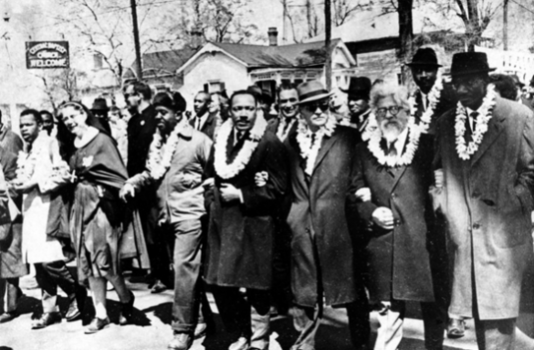Selma’s Missing Rabbi

Marching from Selma: John Lewis of SNCC, an unidentified nun, Rev. Ralph Abernathy; Rev. Martin Luther King, Jr., Ralph Bunche (former U.S. Ambassador to the UN), Rabbi Abraham Joshua Heschel, and Rev. Fred Shuttlesworth
Ava DuVernay’s film “Selma” is a remarkable depiction of a key moment in the civil rights movement, highlighting the strategic savvy, relentless courage, and human frailties of Rev. Martin Luther King, his inner circle of advisors, local grassroots activists, and the many other crusaders who traveled to this rural town to draw attention to the need for a voting rights bill in 1965. Although “Selma” was nominated for an Oscar for Best Film, critics are justifiably outraged by the Academy of Motion Picture Arts and Sciences’ failure to nominate director DuVernay and star David Oyelowo (who plays King) for Oscars.
“Selma” has triggered controversy for its portrayal of President Lyndon Johnson as a reluctant and occasionally hostile ally of the civil rights movement. That debate is over a contentious sin of commission, but critics could also fault the film for a glaring sin of omission: the absence of identifiable Jews and Jewish clergy – particularly Rabbi Abraham Joshua Heschel – from the film.
Three Marches
As the film reveals, there were actually three marches that began in Selma and were supposed to end in Montgomery, the Alabama state capital, as part of the civil rights movement’s campaign to pressure Johnson and Congress to pass the Voting Rights Act. The first march began on March 7 with 600 marchers. State troopers and local cops attacked the unarmed marchers with tear gas and billy clubs while the activists were trying to cross Selma’s Edmund Pettus Bridge. The march, which became known as “Bloody Sunday,” ended on the bridge. Two days later, the marchers tried again. The presence of national media intimidated the state troopers, who stepped aside the let them pass, but – as depicted in the film – King, after getting down on his knees to pray, had second thoughts. He turned around the led the marchers back to a church. He later contacted federal officials, demanding that they protect the protesters along the entire march because Alabama Gov. George Wallace refused to do so.
On March 15, President Johnson delivered his most famous speech before a televised joint session of Congress, where he announced that he would introduce a voting rights bill and uttered the phrase “we shall overcome” to declare his solidarity with the civil rights movement. King believed that the momentum had shifted and decided to resume the march. LBJ committed to send in the U.S. Army, the Alabama National Guard (under federal command), federal marshals and the FBI to guarantee the marchers’ safety. The third march began on March 21. They arrived in Montgomery, 54 miles away, three days later and held a huge rally the following day at the State Capitol building.
All the film clips of those events…



